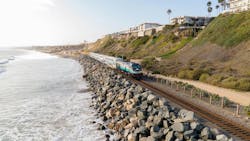OCTA takes significant step to safeguard San Clemente rail corridor
The Orange County Transit Authority (OCTA) Board of Directors on Feb. 10 voted to advance four priority projects under the Coastal Rail Stabilization Priority Project, marking a significant milestone in efforts to safeguard the rail corridor.
“This rail line is essential to safely moving passengers and freight, and I’m proud of the work we are doing with strong input from the community and all stakeholders to make sure this vital corridor remains operating smoothly,” said OCTA Board Chair and Orange County’s Fourth District Supervisor Doug Chaffee.
Since fall 2021, multiple bluff failures and landslides on privately owned land have, along with coastal erosion, significantly impacted rail operations along the Los Angeles – San Diego – San Luis Obispo (LOSSAN) Rail Corridor, requiring emergency stabilization efforts. Subsequently, OCTA says studies indicated that other areas through San Clemente are at risk.
To address the concerns, OCTA has been actively collaborating with regulatory agencies to implement strategic solutions in the near future while continuing to look at short and mid-term solutions to protect the rail line in place. OCTA is also working with the state toward long-term solutions.
OCTA staff has continued to engage with regulatory agencies to find ways to streamline the permitting processes and advance the four identified reinforcement areas. The authority notes priority projects are currently under the environmental and preliminary engineering phase, which would help to ensure the timely implementation of protective measures while aiming to minimize future rail service disruptions.
OCTA advanced the following projects:
- Reinforcement Area 3: A proposed catchment wall at Mariposa Point designed to protect from landslides will be expedited. The authority notes this location does not require permits from the U.S. Army Corps of Engineers or the California State Lands Commission, allowing for accelerated project implementation.
- Reinforcement Areas 1, 2 and 4: OCTA is evaluating multiple protective measures, including riprap repair, engineered revetments, seawalls and sand nourishment to address coastal erosion risks.
Collaborative efforts, funding secured
OCTA is working closely with geotechnical, structural and coastal engineers, alongside key stakeholders such as the city of San Clemente, Calif., State Parks, Southern California Regional Rail Authority (Metrolink), LOSSAN, Amtrak and BNSF Railway.
Last fall, OCTA secured $305 million in state and federal funding, enabling the completion of design and construction for the Coastal Rail Stabilization Priority Project. OCTA continues to work with the U.S. Army Corps of Engineers, the California Coastal Commission and the California State Lands Commission to advance the project under the standard regulatory framework while looking for ways to expedite the effort. The work includes:
- Submitting a coastal development permit application to the Coastal Commission.
- Conducting geological and environmental assessments.
- Identifying and securing sand sources to support beach nourishment.
The authority says a critical component of the project includes a one-time infusion of approximately 540,000 cubic yards of sand for beach nourishment.
OCTA is exploring viable offshore and inland sand sources to support erosion control measures. The authority notes environmental studies and permitting processes are actively being pursued to expedite approvals and ensure efficient project implementation.
Project timeline and next steps
OCTA says the alternative analysis for Reinforcement Area 3 is expected to be finalized by March 2025, with preliminary engineering and environmental documentation completed by early 2026. For Areas 1, 2 and 4, the alternatives analysis process is anticipated to conclude by mid-2025, with preliminary engineering and environmental documentation completed by early 2027. The timeline is subject to change. Additionally, OCTA is coordinating with rail operators to minimize disruptions to passenger and freight rail services once construction begins.
